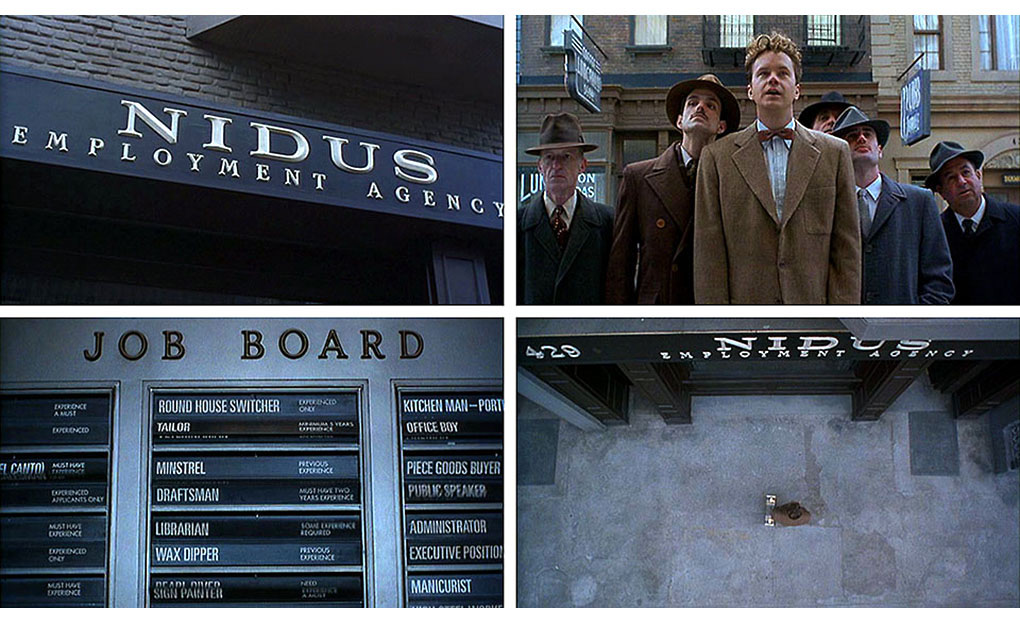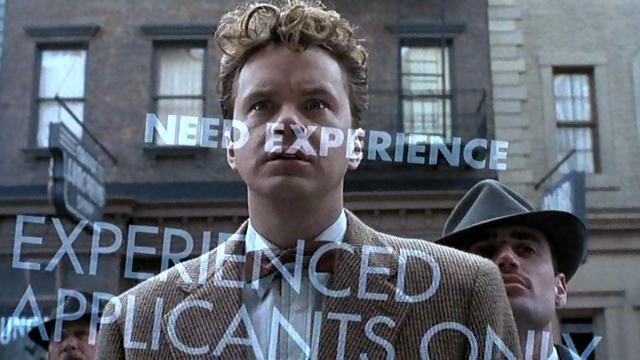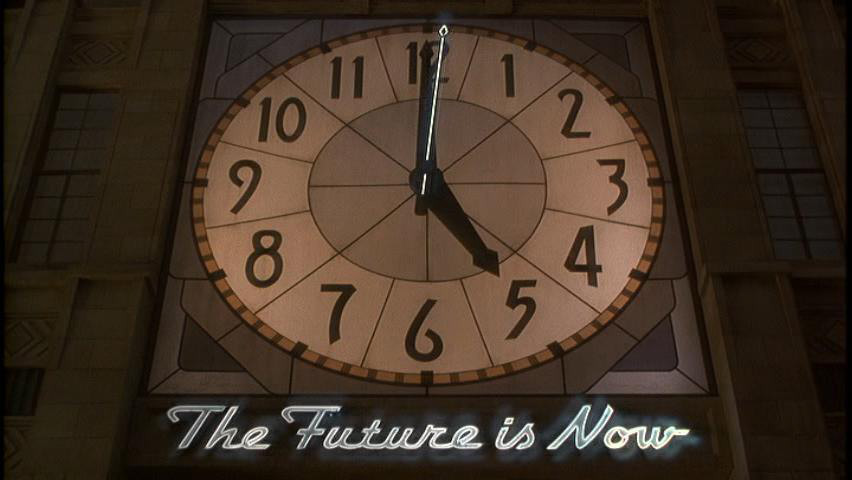
[Image Source: The Hudsucker Proxy]
The steady stream of resumes here at the BUILD World Headquarters has recently turned into a flood of applicants and we’re guessing that this is the result of a number of factors. Within the last few years, the construction industry has picked up substantially in the Pacific Northwest; subsequently the Seattle architecture scene has attracted candidates from all over the world. It’s also that time of year where students are free from the burdens of study and have the opportunity to get some real world experience under their belts. Lastly, we find that having a healthy social media program generates enough interest in our work to significantly boost the frequency of resumes coming through the door.
We’re always honored when a resume hits our desk or our inbox and we’ve gone to great efforts to outline what we consider to be a successful submission. You can read about our guide to resumes here and tips for getting hired here and here.
That said, it’s a bit disturbing to see so much of the same approach from applicants seeking a position in architecture — what we consider to be a profession made up of creatives. It’s always odd to read that someone considers themselves one who thinks-outside-the-box when they’ve sent in a resume and portfolio so similar to their competition. It got us curious as to what actually lands a job, not just in architecture, but at BUILD specifically. (Take this with a grain of salt. This is just our office and the hiring protocols of each office vary widely.) One of the main reasons we put in the time and effort to write the BUILDblog is the exhilarating idea of taking the mystery and obscurity out of architecture. So we went back in time and refreshed our memories on what factors led to the hiring of the architects and interns that make team BUILD, and while the results aren’t surprising to us, they may be a bit discouraging to the typical job applicant. In a nutshell, one thing was very, very clear. Ready for it?
Sending in a resume cold will almost never get you a job here.
We’re sorry to say it, and it’s not necessarily what we intend, but historically speaking, that’s the way it shakes out. On top of that, we’re guessing that most offices would say the same. But if you’re an applicant, you shouldn’t lose hope.

[Image Source: metacafe]
In addition to taking the mystery out of the architecture profession, we also like providing answers. If you’re in the market for an architecture position we think you’ll be very interested in what we have to say next.
We’ve spelled out the top 5 determining factors that led to a hire here at BUILD. These are the factors that differentiated the individuals we’ve hired over the years, from the faceless stack of resumes in our files. And if our professional advice is worth its weight, these factors probably apply to the bulk of architecture firms (maybe even the professional world in general). Along with each factor are some tips as to what you can do as an applicant to boost your chances of landing a job in architecture.
1. Academic reviews are interviews. We regularly sit in on student reviews at the University of Washington’s Department of Architecture and whether the students know it or not, these are informal interviews. Being a jury member is an excellent way to determine who’s got what it takes to make it in architecture. During any given review, we’re looking for technical ability, graphic know-how, good communication skills and most of all, a can-do attitude. When a student presentation has it all, there’s barely a need to interview them further and most of the time we don’t even need to see a resume. Person to person contact trumps words on paper every time.
What you can do: Advocate that your professors bring in jurors for student reviews from firms that you respect and would like to work for. This relationship builds direct access to your target employment market and gives you a reason to reach out to them afterward (plus they can put a face with the name). To put it differently, as a student you’re always interviewing via your presentations — making sure that the right individuals are in the audience is a more effective use of your time and effort.
2. Professor recommendations. When we don’t have time to participate in juries, we’ll simply ask the professors we respect most for the contact information of a couple of their top students. With the right professor, an endorsement like this speaks volumes of a candidate.
What you can do: Work hard in school, go above and beyond the requirements and respect your professors. Put it out there that you’re looking for professional experience so that you’re at the forefront of your professor’s mind when they’re asked for recommendations.
3. Social media interaction. It’s never been so easy to track what your favorite firms are up to, where they’re at around town and how to intersect with them. In the BUILD sphere, there are a number of candidates who have gone from anonymous avatars to acquaintances to potential hires simply because they stay connected with us via our social media channels. Chatting with someone over social media is always more fun than responding to a resume, and when they do decide to send in an application, they’re at the top of the list simply because the conversation with them has already been started.
What you can do: If you’re not tracking the firms you want to work for via Twitter, Facebook, blogs, Houzz, Instagram and anything else in their social media arsenal, you might as well be chiseling your resume onto stone tablets. Connect, contribute, put your neck out there. Social media is not a trend, it’s become an evolution of how we all connect.
4. Social interaction. Nothing beats the advantage of meeting people face to face, and Seattle has a great scene for lectures, tours, parties and events. Like most architects, we like to get away from our monitors at the end of a long day, grab a drink and engage with our city. We love being social and, as long as it’s not all shop-talk, we’re always up for meeting new people. The individuals who show up to all the right events at the right times get remembered. We also have a great deal of respect for people who maintain a healthy work-life balance.
What you can do: Connecting with your favorite firms via social media leads to more opportunities for social interaction than you’ll even have time for. Chatting with a potential employer at a social gathering is a great excuse for a follow-up email thanking them for their time. It keeps the conversation going and it’s a strategic time to include a resume that they can associate with the face. As an example, each quarter ARCADE Magazine throws a launch party for their new magazine issue. They pick a hot new venue for each party, fill it with go-getter architects, serve alcohol (important for getting architects out of their shells), and create a fun atmosphere. If you’re looking for an architecture position in Seattle and you’re not attending parties like this, you are shooting yourself in the foot. It’s as simple as that. Get out there.
5. Promote the firms you like. One of the best aspects of social media is that you can track who’s talking about you. The individuals and groups that talk about and forward BUILD are considered champions to us. Whether it’s past clients, the media or young architects who admire our work, we take note.
What you can do: Embrace the platforms and tools out there, using them to promote the people, organizations and designs you believe in. There isn’t a successful company on the planet that doesn’t pay attention to the champions promoting them. Architects may be a bit reticent in their praise, but they’re big fans of being talked about.
There it is, a straight-forward and honest look at how team BUILD differentiated themselves from a stack of resumes. We’re willing to bet our office bar that these 5 factors are applicable to the industry in general — and that they’ll give an edge to any potential candidate trying to land a job in architecture.

[Image Source: The Hudsucker Proxy]
Cheers from team BUILD





